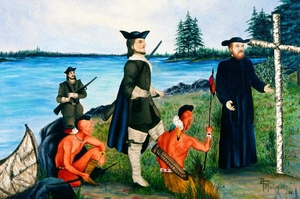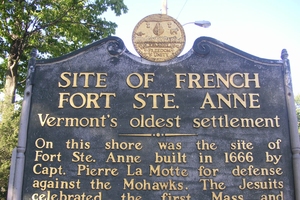L'Isle de la Motte
For English version, please click on the flag 
L'Isle de la Motte est une île du Lac Champlain située sur la côte nord-orientale de celui-ci.
L'Isle de la Motte fut la location du premier établissement Blanc dans la contrée qui aujourd'hui est appelé
Vermont. Les
Français en ce milieu du XVIIème siècle souhaitaient contrôler complétement la rivière Richelieu qui reliait le
Saint-Laurent au Lac Champlain. Pour ce faire ils décidèrent de construire une position fortifiée au nord du Lac.
En 1666, les Français construisirent le Fort Sainte Anne sur l'île pour se protéger des Indiens. Le fort fut construit
sous la direction de Pierre de Saint Paul, seigneur de La Motte. Le fort comptait une garnison de trois cents hommes qui
appartenait au Regiment de Carignan, sous les ordre de La Motte. Le père Jésuite Isaac Jogues était l'aumonier de
cette garnison.
Au sein du fort existait une chapelle dédiée à Sainte Anne, mère de la Sainte Vierge.Les indiens Mohwak impressionés par
cette construction appelèrent le Fort : Tgawistaniyonteh, ce qui signifie "Une cloche est suspendue".
Island La Motte
Originally called Isle of Mott in its charter, but very early the original French form of the name was adopted, and usage
has given it authority. Some historians have said that Isle La Motte was chartered in conjunction with the Two
Heroes (see North Hero, South Hero or Grand Isle), but the records of the Legislature and those of the Governor and
Council show that there were two separate groups of petitioners, two grants and two charters for the two different
tracts of land. The charter for Isle La Motte lists 96 names, headed by Benjamin Wait, who later settled Waitsfield. The
Two Heroes went to 365 men, with Ethan Allen and Samuel Herrick at the head of that list. Some names appear in both charters,
but fewer than might be expected in view of the fact that both were chartered exclusively to Vermont veterans of the
Revolutionary War.
The island of the lake Champlain takes its name from the first white settlement within what is now Vermont. In 1666 the French built Fort Sainte Anne
on the island as protection against the Indians. The fort was constructed under the supervision of Pierre de St. Paul,
Sieur de la Motte and garrisoned by 300 troops of the Carignan Regiment, with la Motte in command. As the name indicates,
a shrine dedicated to Saint Anne was on the site, and there the troops worshipped under the Jesuit priests who accompanied
the regiment.

Consécration of the location dedicated to Sainte-Ann by La Motte and father Jogues.
After four years the troops were pulled back to Canada, the fort was destroyed by the French, and la Motte
was made commander at Montreal; but historically his name has always been associated with the island. The Indians never
forgot the shrine, and the Mohawk called the place Tgawistaniyonteh, meaning "there a bell is suspended."

War against the Iroquois.
Just before the
turn of the 20th Century the Roman Catholic Diocese of Burlington acquired the site and constructed a new shrine to Saint
Anne, which today is the single most popular reason to visit the island.
In 1802 the town's name was changed from Isle La Motte to Vineyard. The official records give no indication of the rationale
behind the change, but it must have been at the instigation of the townspeople themselves, because the legislature never
made any arbitrary name-changes. Generally speaking, throughout the United States, the name Vineyard has been used in places
that either had large numbers of grapes or wanted to be known as grape growing areas. Probably the former reason applied
here, but Hamilton Child may have hit upon another reason in his Gazetteer, without even being aware of the significance of
what he said, when he noted that "the people of the island are generally of English and Scottish descent." That being the
case, they may not have liked the French flavor of their town's name. Whatever the reason, the change was not a permanent
one: in 1830 the name was changed back to Isle La Motte.
The town's first post office was established in 1829 as Vineyard and, in a quirk of history (but consistent with postal
behavior), the name stuck until 1853, when finally it, too, was changed to Isle La Motte, 23 years after the official
reversion of the town name.
The town's only other post office was Fisk, which took its name from one of the oldest families on the island. Ichabod Fisk
came to Isle La Motte in 1788 and settled in the southwestern part of town, where he developed the first marble quarry in
the state. Fisk was involved in all the early activities of his town. He taught school for several terms and was a noted
surveyor: in fact it was he who did the original survey for the allotment of the town. The post office of Fisk, opened
in 1892 and closed in 1929, took its name directly from the first postmaster, Nelson W. Fisk.
During the decades around the turn of the 19th Century, Nelson Fisk was one of the county's most prominent men. In addition
to running quarries that supplied stone for many famous buildings throughout the eastern United States, he was the town's
representative to the Legislature. Later he served as a county senator, and was a delegate to the national Republican
convention. In 1896 he was elected Lieutenant Governor of Vermont. It is said that he kept all the accounts of the quarries,
the store and the post office in his head. Naturally, postal authorities took a dim view of Fisk's accounting
procedures. It was his practice to say "the post office is allowed to have $100 worth of stamps at any
time, so here is a $100 bill in the drawer. Any time you want it you can take it, and the stamps are mine."
With the friends Fisk had in high places, postal authorities were helpless to change his ways. In fact, Vice
President Theodore Roosevelt was staying at Nelson Fisk's Isle La Motte home when word reached him that President
McKinley had been shot.

Commemorative Pannel.

Statue of Samuel de Champlain.
![]()







